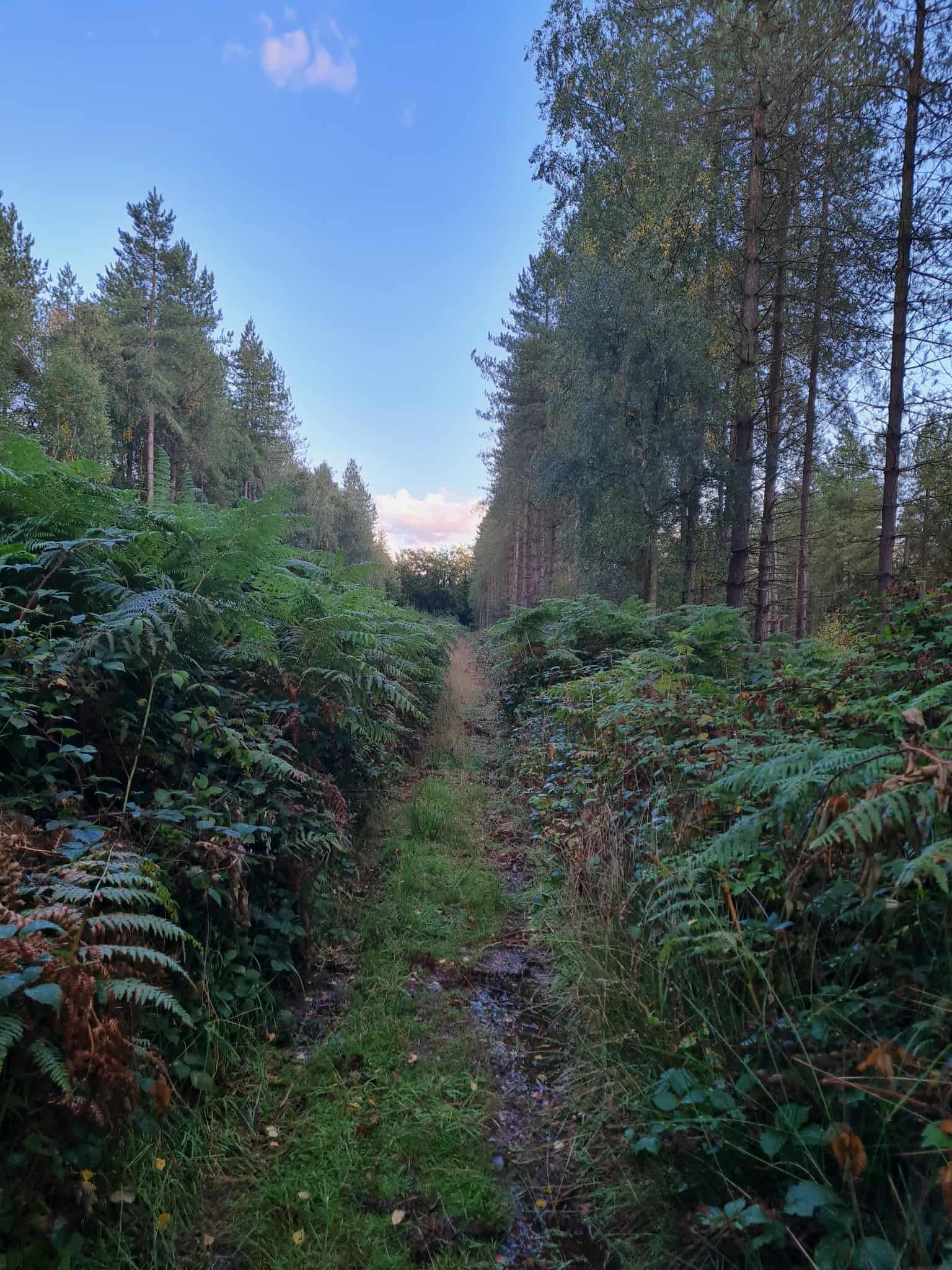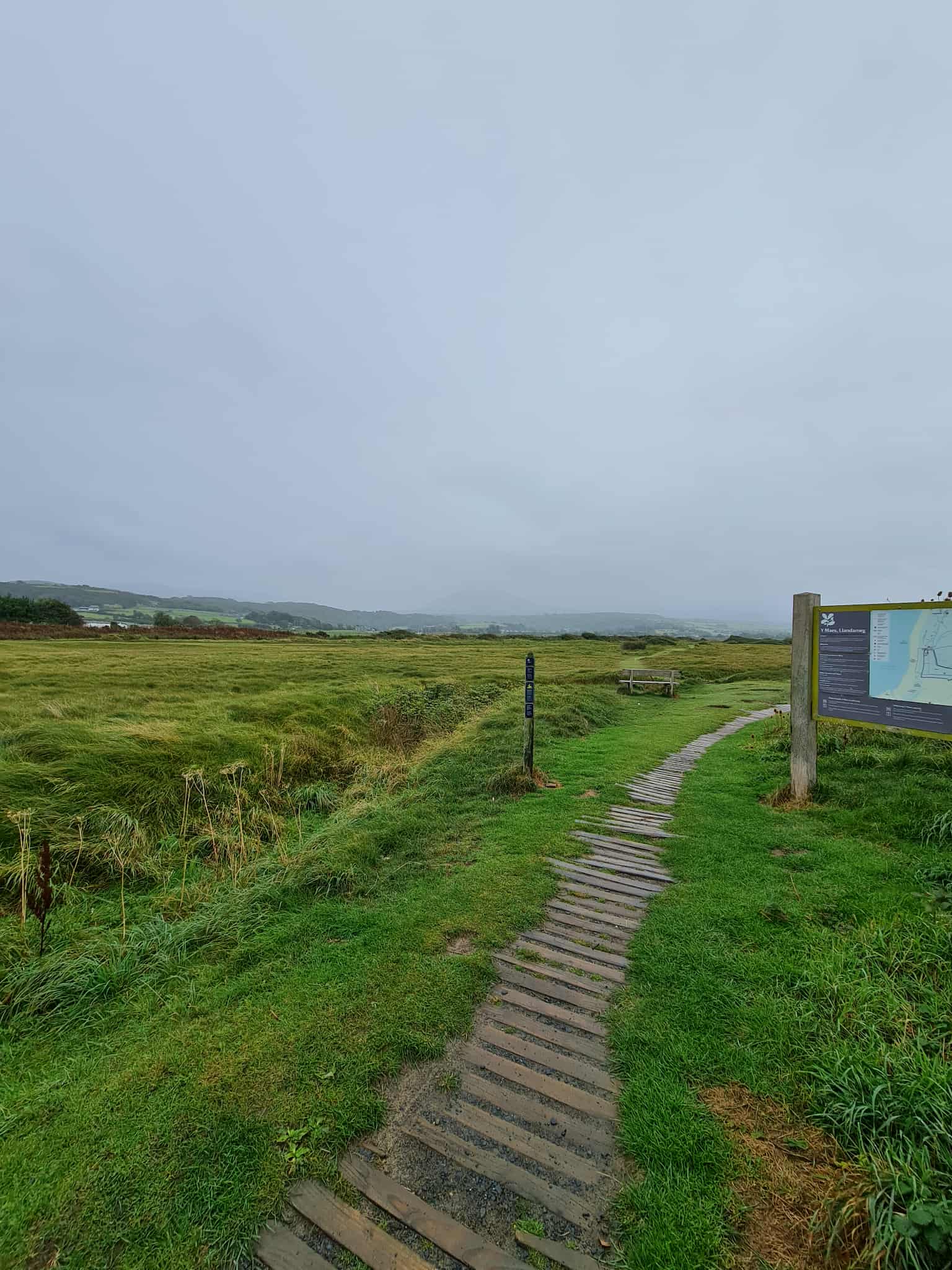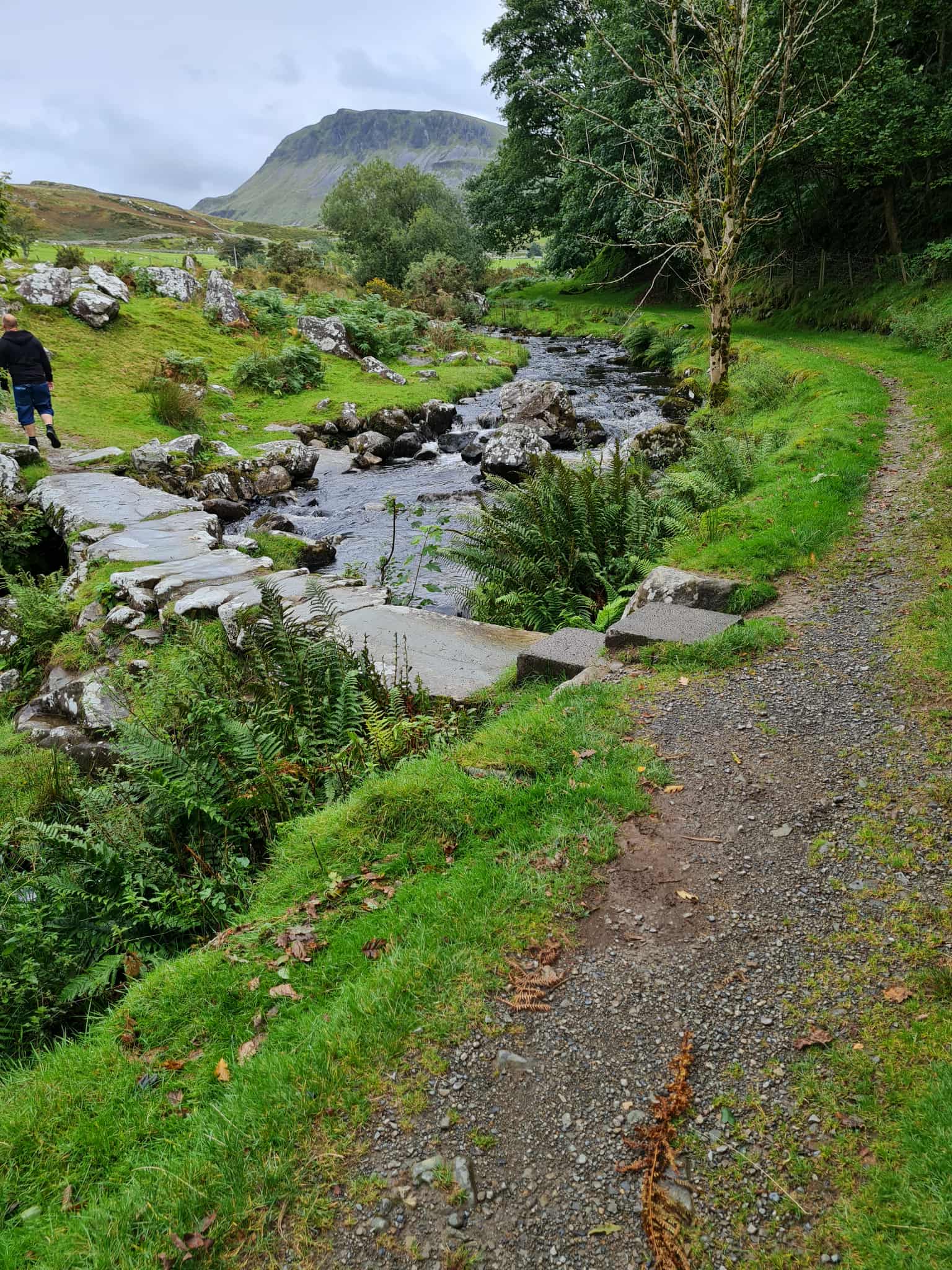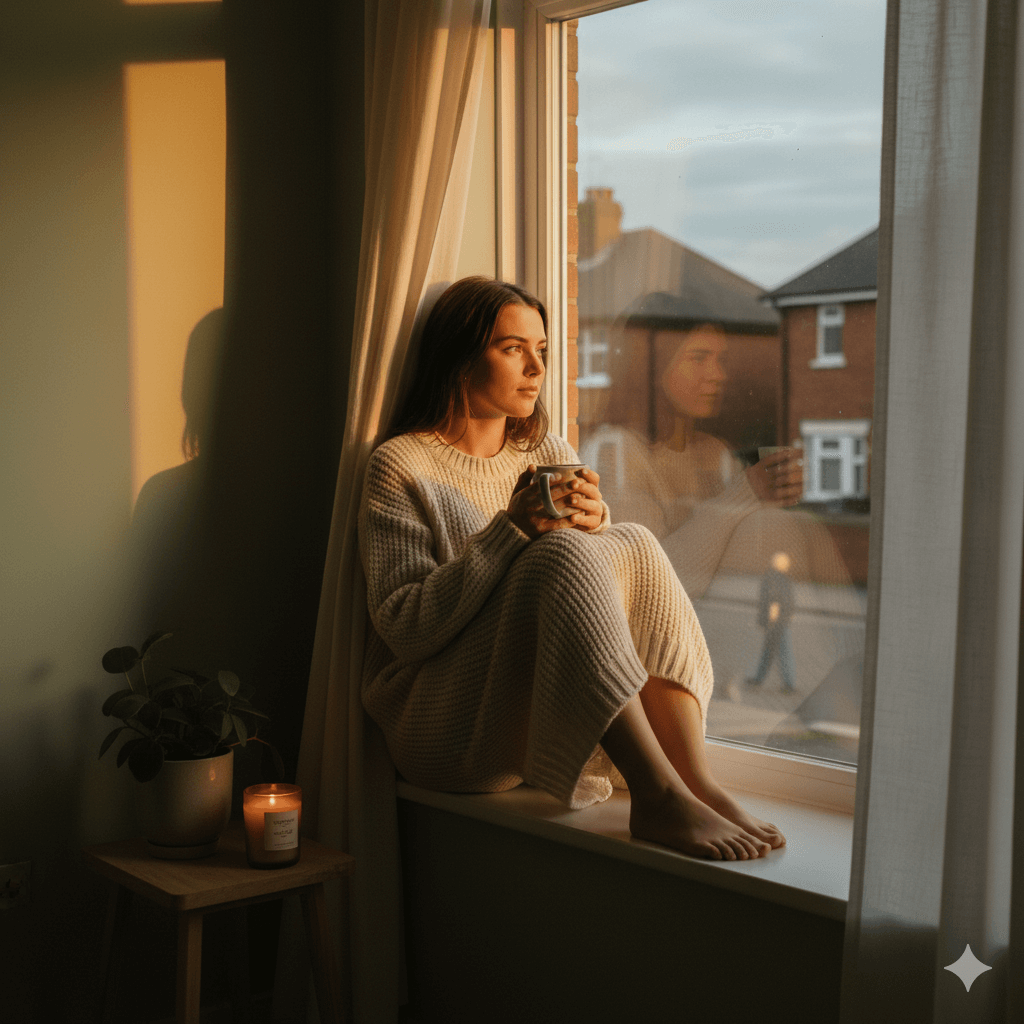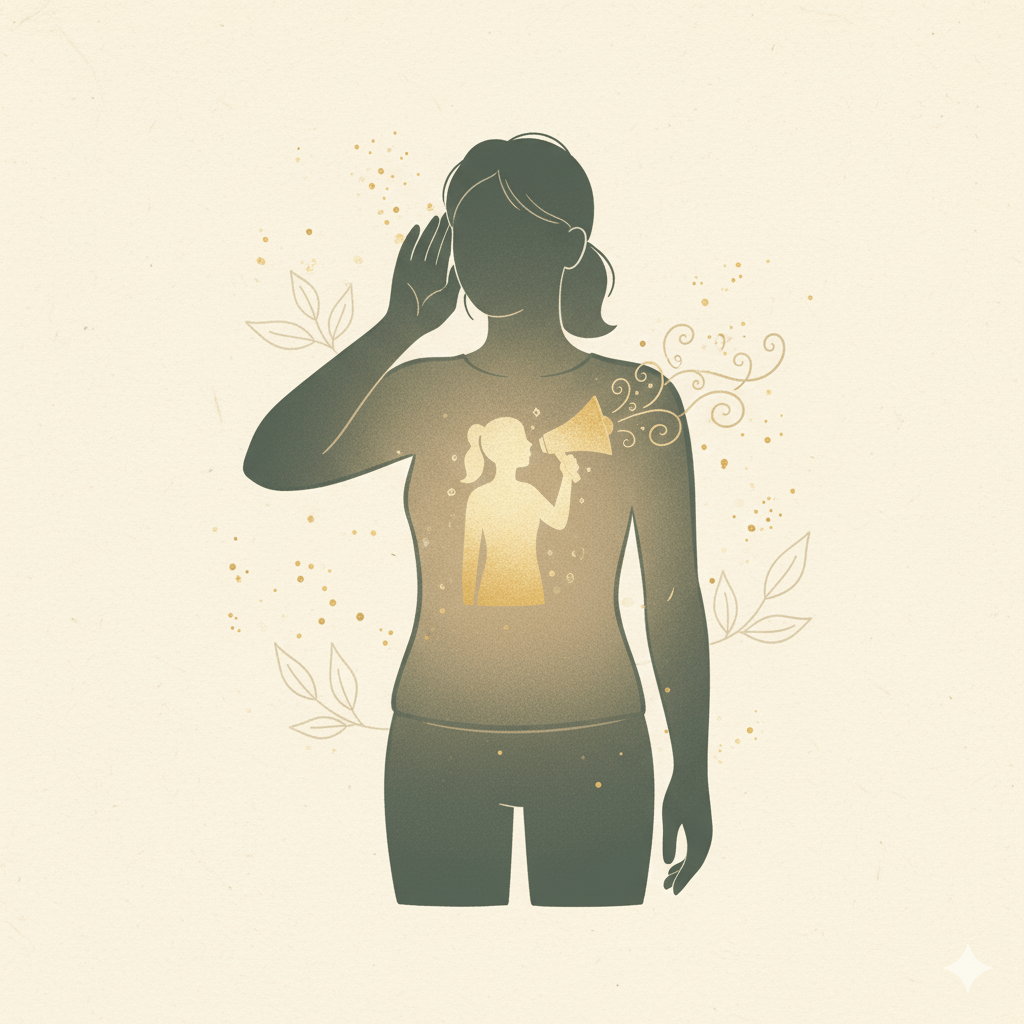by Kel • October 20, 2025 – Read time 20 mins
Walking may look simple, but the benefits of walking go far beyond fitness. From mental clarity to stronger joints, it’s one of the most underrated forms of exercise—and it might be the foundation habit you’ve been missing.
The Problem: You’re Moving Less Than You Think
Here’s what nobody tells you about feeling tired all the time:
The exhaustion isn’t because you need more coffee. It’s not because you’re lazy. And it’s definitely not because you lack willpower.
It’s because you’re barely moving.
I know how that sounds. Walking seems too simple to matter. Too boring to count as “real” exercise. The gym is for people who already have their life together. Running hurts. Yoga classes are expensive. And who has the energy for a “workout” when you’re already exhausted from just existing?
But here’s the thing: if you’re getting under 5,000 steps a day, your body and mind are quietly paying a price. Moreover, you can feel it.
I discovered this the hard way when I found my daughter’s old step-tracking watch buried in a drawer. On a whim, I wore it for a day. The number that came back? 3,000–4,000 steps.
Suddenly, everything made sense. The afternoon energy crashes. The nagging back pain. The constant brain fog. The feeling of being tired but wired at the same time.
I wasn’t broken. I was just… still.
- The Hidden Cost of Staying Still
- The Solution: Walking Changes Everything
- The Return of Walking Culture
- The benefits of walking on Your Brain?
- The benefits of walking for Your Physical Health
- Why Is Walking Called a Keystone Habit?
- 3 Actions You Can Take Today
- Everyday Mastery Steps You Can Take Now
- Common Walking Obstacles (And How to Overcome Them)
- The Questions Nobody Asks Out Loud
- Walking Trends Worth Trying in 2025
- What People Are Asking About Walking
- Frequently Asked Questions
- What If Walking Became Your Foundation?
- Before You Go: A Moment of Reflection
- Ready to Build Your Own Foundation?
- Final Thoughts: Why This Matters

The Hidden Cost of Staying Still
Those low step counts aren’t just numbers on a screen.
They’re why you can’t think straight by 2pm, even after your third coffee. Your back aches for no clear reason. Stress feels impossible to shake, no matter how many deep breaths you take or productivity hacks you try.
Additionally, here’s something most people don’t know: research shows that people averaging under 5,000 steps daily face 50-70% higher health risks compared to those hitting 7,000+ steps. That’s not a small difference. That’s your body quietly paying a price.
And here’s the part nobody talks about: the guilt.
You know you should move more. The articles have been read. Plans have been made. Maybe you’ve even bought the gym membership, the running shoes, or downloaded the fitness app. Nevertheless, at the end of a long day, putting on shoes and going outside feels like climbing Everest.
So you don’t. Then the guilt sets in. And the cycle continues.
Here’s the truth: your body is designed to move. Without regular movement, your nervous system stays dysregulated. Joints weaken from underuse. Mood dips. Energy flatlines.
Furthermore, here’s the kicker: all those intense workouts you’ve been avoiding? They won’t fix this.
Because the problem isn’t that you need more exercise. It’s that you need more movement—the kind that happens throughout your day, not just in a scheduled 45-minute block.
I kept thinking I just needed better coffee. Or finally that gym membership. Or more willpower.
However, I was trying to solve the wrong problem. You’re not lazy. You’re just understimulated.
The Solution: Walking Changes Everything
The solution isn’t more intense. It’s more consistent.
And it starts with something so simple you’ve probably been overlooking it: walking.
Not power-walking with ankle weights. Not “exercise walking” in designated workout clothes. Just regular, everyday walking—the kind you can do while thinking, listening, or simply being present.
According to neuroscientist Dr. Andrew Huberman from Stanford University, the benefits of walking are one of the most underrated forms of exercise for both mental clarity and physical health. His research shows that walking does something remarkable to your brain—it creates what’s called “optic flow.”
As Huberman explains in his research on walking and stress reduction: “Self-generated optic flow—by walking, running, or cycling—shifts the brain into a state of relaxation that’s not seen when you’re stationary. When you move through a space and you’re active, there’s a natural calming of the brain circuits involved in threat and threat detection.”
In other words, walking literally quiets your stress response at the neurological level.
But the real magic? It doesn’t feel like exercise. Which means you’ll actually do it.
When I started adding just 1,000 steps at a time—no dramatic overhaul, no rigid schedule—something shifted. Not overnight. But gradually, consistently.
These days, I hit 10,000-12,000 steps most days. Moreover, the transformation wasn’t just physical.
So let me show you what walking can do for your mind, your body, and your entire approach to building habits.
The Return of Walking Culture
Before we dive into the science, it’s worth noting: something interesting is happening in 2025. Walking is having a cultural moment.
On one end of the spectrum, “epic walking” is exploding worldwide. The Camino de Santiago in Spain saw record numbers in 2024, with people seeking spiritual reset and mental clarity through long-distance pilgrimage. Modern walkers are rediscovering what ancient traditions knew: walking isn’t just exercise—it’s a form of moving meditation, a way to process life at a human pace.
On the other end, science is validating what our bodies have been telling us: short, frequent micro-walks (just 1–5 minutes) throughout the day may be even more powerful for circadian balance and longevity than one long walk.
These aren’t opposing ideas. They’re two sides of the same coin: walking as a return to sustainable, human-scaled movement in a world that’s been pushing us to go faster, harder, longer.
You don’t need to walk the Camino to benefit from this shift. You just need to reclaim walking as something meaningful—not just a means to an end.
Whether you’re taking a 2-minute walk to reset between tasks or planning a weekend hiking adventure, you’re part of a broader movement toward slower, more intentional living.
the benefits of walking on Your Brain?
When you’re walking, your brain gets to do something it rarely does anymore: process without pressure.
There’s no screen to stare at. Productivity isn’t being forced. You’re just moving—and that movement creates space for clarity.
The Science Behind the Calm (In Plain English)
Research shows that walking, especially mindful walking, helps regulate your nervous system. A Stanford University study found that walking boosts creative output by 60 percent. Similarly, Harvard Health confirms it literally clears mental clutter and reduces anxiety.
But what’s happening in your brain goes even deeper. When you walk, your eyes naturally move from side to side, taking in your surroundings. As a result, this creates “optic flow”—and it has a powerful calming effect.
Dr. Huberman notes that this visual phenomenon reduces activity in the amygdala, the part of your brain responsible for fear and anxiety. The actual movement of objects past you as you walk quiets the circuits responsible for stress. It’s similar to certain therapy techniques that use eye movements to help people process trauma and reduce anxiety.
Studies show that just 20 minutes of walking can reduce your body’s stress hormone (cortisol) by 10-15%. That’s a real, measurable decrease in what’s making you feel anxious.
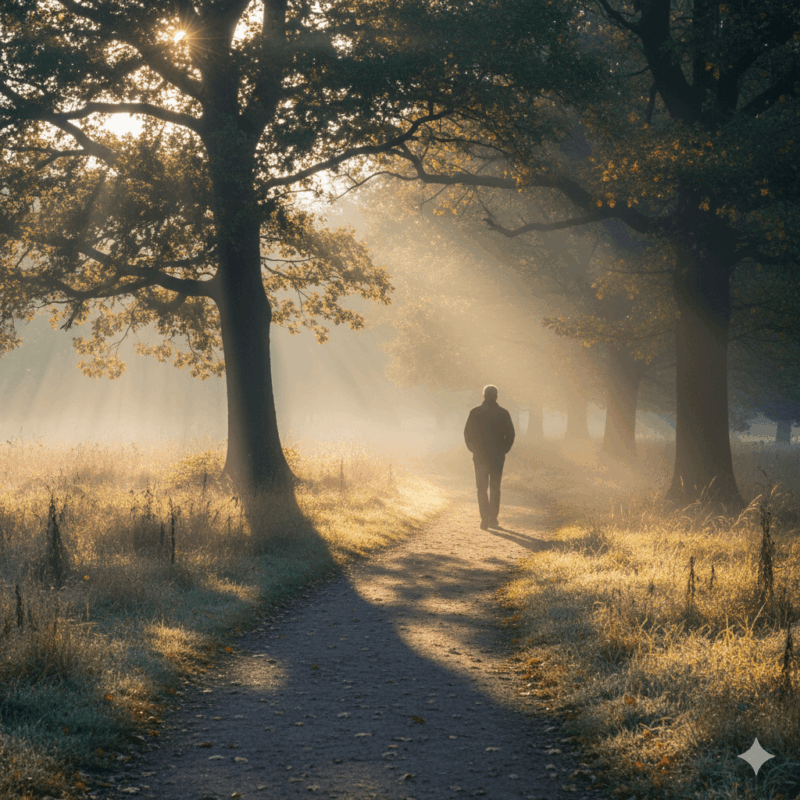
OPTIC FLOW EXPLAINED IN 3 SIMPLE POINTS:
- What it is: The visual pattern your eyes naturally track as you move through space—trees passing by, sidewalks flowing beneath you
- What it does: Reduces activity in your amygdala (your brain’s fear center) by calming the circuits that keep you on edge
- Why it matters: Creates a neurological reset that sitting still simply can’t replicate—it’s why solutions appear during walks
Think about it: when you’re working at a computer, your eyes aren’t moving. What you see is two-dimensional and fixed in space. Creating optic flow through walking is the direct opposite of what most people are doing all day.
How Walking Upgrades Your Brain Hardware
Here’s where it gets really interesting. Recent research shows that walking doesn’t just calm your brain—it actually rewires it.
A 2023 review published in the Royal Society B examined how walking and locomotion affect visual processing and found that walking sharpens your brain’s sensitivity to motion speed and visual-spatial awareness. Your brain is literally fine-tuning the circuits that maintain balance, alertness, and spatial processing.
The research mapped how optic flow creates a complete neural network effect: when you walk, your brain stabilizes your gaze, reduces cognitive load, and enhances emotional regulation—all at once.
Think of it this way: your brain is constantly processing information. When you’re sitting still, staring at a screen, it’s like your mental RAM is maxed out. When you walk, you’re giving your brain a different kind of task—one that actually frees up processing power for everything else.
This is why solutions to problems often appear during walks. You’re not forcing your brain to think differently. You’re literally optimizing its hardware to think more clearly.
And here’s something powerful: research looking at depression found that walking 30 minutes, three times per week, was as effective as medication for people dealing with mild to moderate depression. That’s not just “feeling a bit better”—that’s a real, clinical improvement.
Walking is one of the easiest ways to start exercising when overweight. It builds consistency without pressure or pain.
Two Ways to Walk
Here’s what this looks like in practice:
You can walk mindfully – tuning into the sights, sounds, and sensations around you. It becomes a moving meditation, a break from the constant noise in your head. Notice the trees, the light, how your feet feel on the ground. This is “forest bathing” without needing a forest. (If this approach resonates with you, I share a deeper practice in mindful walking for forest discovery.)
Or you can walk with purpose – listening to a podcast, an audiobook, or music that lifts your mood. It transforms the walk into a mobile learning session. Your brain is still getting the optic flow benefits while you’re feeding your mind something nourishing.
Either way, you’ll return home feeling refreshed and focused in a way that scrolling your phone will never give you.
When I started my morning walks, I noticed something unexpected: they set my mental tone for the entire day. On days I skipped? I felt it. The fog crept back in.
If you’re feeling scattered, anxious, or mentally stuck, walking might be the reset you didn’t know you needed.
For more inspiration on mindful walking, check out Mindful.org’s walking meditation guide.
The benefits of walking for Your Physical Health
You probably won’t walk your way to six-pack abs. And that’s okay—because the benefits you will get are the ones that actually improve your daily life.
Real Changes You Can Feel
Your back pain might ease. Walking strengthens the stabilizing muscles that support your spine, especially if you sit for hours each day. The gentle movement helps decompress your spine and improve circulation to the muscles supporting your back. Clinical trials show that 12 weeks of daily walking reduced chronic low back pain by 40%. That’s real relief without pills or expensive treatments.
Your posture will improve. Regular movement counteracts the forward slump that comes from desk work and phone scrolling. As you walk, your body naturally finds better alignment.
Your joints will feel stronger. Walking is low-impact strength training for your knees, hips, and ankles—without the wear and tear of running or heavy lifting. The movement lubricates your joints and builds the muscles around them.
Your energy will soar. This one surprised me most. Morning walks now wake me up better than coffee ever did. That’s because walking increases circulation, delivers oxygen to your cells, and triggers the release of energizing hormones.
Your sleep will improve. Research shows that people who walk 150 minutes weekly (that’s just 20 minutes a day) improve their sleep quality by 65% compared to non-walkers. Better sleep means better everything else. And if you’re in the UK, you might notice this effect even more pronounced during autumn and winter when our bodies naturally crave more rest—I explore this seasonal shift in how your body changes in autumn.
Your heart gets healthier. Walking strengthens your cardiovascular system, helps lower blood pressure, and improves circulation—all without the intensity that might keep you from doing it consistently.
What the Research Shows about the benefits of walking
According to Harvard Health, regular walking provides powerful health benefits including:
- Improving circulation
- Strengthening bones
- Improving sleep quality
- Maintaining weight and burning calories
- Boosting immune function
- Helping lower blood sugar
- Supporting joint health
- Lowering Alzheimer’s risk
The British Heart Foundation notes six surprising health benefits of walking that many people don’t realize, from strengthening your heart to improving mood and even supporting your immune system. And if you’re in the UK, the NHS walking for health guidance confirms that brisk walking counts as moderate-intensity aerobic activity with significant health gains.
Walking won’t replace intense workouts if that’s your goal. But it’s effective, sustainable, and accessible in ways that gym routines often aren’t.
You don’t need equipment. Memberships aren’t required. Rigid schedules? Not necessary.
It meets you exactly where you are.
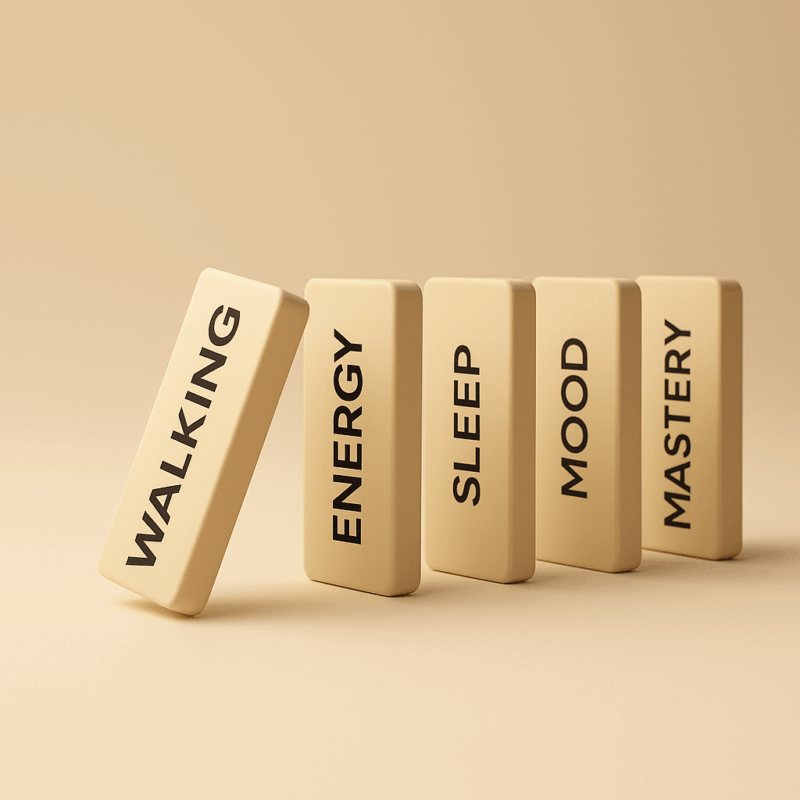
Why Is Walking Called a Keystone Habit?
Here’s where it gets interesting.
Walking isn’t just about the steps themselves. It’s what I call a keystone habit—a habit that creates positive momentum in multiple areas of your life.
James Clear, author of Atomic Habits, calls this effect “habit stacking”—when one good habit naturally leads to others. Walking is one of the most powerful examples of this.
Once you commit to walking daily, you start to:
- Build the identity of someone who values their health
- Create time for thinking, reflection, and presence
- Prove to yourself that you can show up consistently
And then something unexpected happens.
You start making other good choices without forcing them. Drinking more water becomes natural because you’re thirsty from the walk. Sleep improves because your body actually moved. Healthier meals become appealing because you’re already in a “taking care of myself” mindset.
After I started walking regularly, I noticed these shifts happening naturally. I wasn’t white-knuckling my way through a rigid health plan. The momentum just… built.
Interestingly, researchers studying Blue Zones—regions where people live the longest, healthiest lives—found something similar. The world’s healthiest populations don’t “exercise.” They just walk naturally throughout their day. Movement is woven into their lifestyle, not scheduled into it.
Why Small Habits Work
That’s the power of starting with something simple. Walking doesn’t just change your body. It changes your identity.
When your identity shifts from “someone trying to get healthier” to “someone who walks every day,” everything else becomes easier. You’re not constantly making decisions about whether to move or not. You just do it. It’s who you are.
And when your identity shifts, other habits follow. You’re more likely to take the stairs. Park farther away. Stand during phone calls. Movement becomes your default, not something you have to force.
That’s Everyday Mastery in a sentence—small, consistent actions that build the foundation for everything else.
The Science of Making It Stick
Here’s what recent habit research reveals: the key to building a lasting walking habit isn’t willpower—it’s context.
Studies on habit formation show that people who pair their walks with specific environmental cues (finishing breakfast, closing their laptop at lunch, making their evening tea) have dramatically higher consistency rates than those who just “try to remember to walk.”
The reason? Your brain loves automation. When you attach a new habit to an existing routine, you’re hijacking a neural pathway that’s already established. James Clear, author of Atomic Habits, calls this effect “habit stacking”—when you link new behaviors to existing routines to create automatic triggers. (I dive deeper into exactly how to use this technique in my complete guide to habit stacking.)
So here’s how to use this:
Pick your cue: Choose something you already do consistently. Every time you finish your morning coffee. Right after you close your laptop for lunch. When you start making dinner.
Make it obvious: Put your walking shoes by the coffee maker. Set a phone reminder. Create a physical cue that reminds you.
Start tiny: Research shows that even 2-minute walks, when triggered by consistent cues, grow naturally over time as the habit strengthens.
The goal isn’t to force yourself to walk through willpower. It’s to set up your environment so walking becomes the path of least resistance.
3 Actions You Can Take Today
- Add 1,000 steps to your day.
Take a 10-minute walk after your morning coffee or lunch. That’s all you need to start the chain reaction. - Pair your walk with a cue.
Link it to something you already do — closing your laptop, making tea, or finishing dinner — so it becomes automatic. - End one day this week with a walk instead of scrolling.
Trade ten minutes of screen time for movement. Notice how your mind feels afterwards.
Everyday Mastery Steps You Can Take Now
These aren’t fitness goals. They’re small resets, gentle reminders that movement is medicine for your mood, not a punishment for your body.
- Start noticing your energy on the days you walk versus the days you don’t.
- Pay attention to when your inner critic gets loud — and walk through it.
- Treat every walk like a moving meditation, not a metric to hit.
You’re already doing more than you think. Every step counts toward balance, not perfection.

Mr Critic Moment
You walk hah , you tried this before and failed !
Yeah that voice that showed up the moment you started reading this and said: ” this won’t work for YOU.”
The voice that’s already listing all the reasons why walking is fine for other people, but your situation is different. Your schedule is busier. The neighborhood isn’t safe. Your knees hurt. You’ve tried this before and it didn’t stick.
That voice? That’s Mr. Critic. And he’s a liar.
Here’s what Mr. Critic doesn’t want you to know: he shows up loudest right before you’re about to change something. He’s not protecting you. He’s protecting your comfort zone. There’s a difference.
The truth? Mr. Critic gets quieter every time you prove him wrong.
So here’s what you do: Walk anyway. Not to prove anything to anyone else. To prove to yourself that the voice doesn’t get to decide.
Begin small. Start imperfect. Start today.
Watch Mr. Critic lose his power, one step at a time. (If that inner voice keeps showing up, I wrote about how a simple walk can override your inner critic and why movement is one of the fastest ways to quiet self-doubt.)
Common Walking Obstacles (And How to Overcome Them)
Let me address the concerns that might be holding you back—the ones people don’t always say out loud:
“I don’t have time”
You don’t need an hour. Start with 10 minutes. That’s 1,000 steps. You can walk while:
- Taking phone calls
- Listening to podcasts or audiobooks
- During your lunch break
- Before or after dinner
- While your coffee brews in the morning
The question isn’t “Do you have time?” It’s “What are you willing to stop doing or do differently?” (Hint: you probably have 10 minutes of scrolling you won’t miss.)
Here’s what I do: While dinner is cooking, instead of standing in the kitchen scrolling my phone, I do a 10-minute walking video from GetFitWithRick on YouTube—his videos are perfect for quick indoor walks. By the time my food is ready, I’ve got 1,400 steps in. Time I was already spending, just used differently.
If you work from home or want to maximize your time, a walking pad under your desk can be game-changing. I can walk during calls, while reading, or watching shows. Movement woven into life, not added to it.
“I live in an unsafe area” or “The weather is terrible”
Indoor walking counts too. I promise. Try:
- Walking around your home or apartment (yes, even pacing counts)
- Mall walking before stores open
- Walking up and down stairs
- Following a walking video on YouTube
- Using a treadmill at a gym or community center
Even walking in place while watching TV creates that optic flow effect your brain craves.
“I get bored easily”
Make it engaging:
- Rotate between different routes to keep things interesting
- Listen to podcasts, audiobooks, or music that actually excites you
- Try walking meditation or gratitude practice
- Take photos of things you notice
- Walk with a friend or family member (accountability + connection)
- Set mini-challenges (find 5 red things, spot 3 different birds)
Boredom is just your brain’s way of saying it needs stimulation. Give it something to focus on.
“I have mobility issues”
Walking doesn’t have to mean a traditional walk. Movement is movement:
- Use a wheelchair or walker—you’re still moving, and it counts
- Focus on whatever distance feels comfortable
- Break it into smaller chunks (three 5-minute walks instead of one 15-minute walk)
- Talk to your doctor about what’s appropriate for you
The goal is more movement than yesterday, not perfection. Your version of walking is valid.
“I’m too out of shape to start”
This is the most common fear, and I need you to hear this: Walking is how you get in shape. You can’t be too out of shape for the starting point.
Begin slower. Rest more. Walk for 2 minutes if that’s what you’ve got. That’s still 2 minutes more than you were doing. And that counts.
The Questions Nobody Asks Out Loud
“Will I look stupid just walking around my neighborhood for no reason?”
No. And honestly? Everyone else is too busy with their own life to notice. But if you’re self-conscious, try headphones. It gives you a “reason” to be out there. Within a week, you’ll stop caring what anyone thinks.
“What if I can only do 5 minutes before I’m exhausted?”
Then you do 5 minutes. That’s 5 more than you were doing. Tomorrow might be 6 minutes. Or it might be 5 again. Both are fine. Small counts. Slow counts. Inconsistent still counts.
“When will this actually start feeling good?”
Honest answer? Sometimes it takes a few weeks. The first walks might feel like a chore. Your body might resist. But somewhere around week 2 or 3, something shifts. You start craving it. Your body starts asking for it. That’s when you know it’s working.
“Does walking even count if I’m not sweating or out of breath?”
Yes. This isn’t about intensity—it’s about consistency. Walking isn’t about burning maximum calories. It’s about regulating your nervous system, clearing your mind, and reminding your body what movement feels like. All of that happens whether you’re sweating or not.
“What if I miss a day and ruin my streak?”
You didn’t ruin anything. Missing one day doesn’t erase your progress. Life happens. What matters is showing up again tomorrow. The “all or nothing” mindset is what sabotages people. Some walking is always better than no walking.
Walking Trends Worth Trying in 2025
If you want to shake up your walking routine or take it to the next level, here are three evidence-backed approaches gaining traction:
Reverse Walking (Retro Walking)
Walking backward is going viral on social media—and for good reason. It strengthens your hamstrings, improves balance, and forces your brain into heightened focus mode. The unusual movement pattern challenges your coordination and spatial awareness in ways that forward walking doesn’t.
Start with just 30 seconds to 1 minute in a safe, open space. Your coordination will improve faster than you expect. Some people incorporate retro walking into their regular routes, alternating between forward and backward walking.
Japanese Walking Method
This approach focuses on posture alignment and rhythmic breathing while walking. The practice has been associated with reduced inflammation markers and better cardiovascular health.
Key principles: maintain an upright posture, engage your core, and coordinate breath with steps (inhale for 3 steps, exhale for 3 steps). It’s less about speed and more about mindful movement and proper form.
Intensity Over Distance
New research is debunking the myth that you need to run to burn significant calories. Steady walking—especially when you occasionally increase your pace or add inclines—can match running’s calorie burn while being far more sustainable for joints and long-term consistency.
The key is varying your intensity rather than maintaining the same pace for every walk. Add in some brisk intervals, find hills or stairs, or simply pick up your pace for a few minutes at a time.
You don’t need to adopt all of these. But experimenting with different approaches can keep walking fresh and engaging, especially if you’ve been walking the same route at the same pace for months.
What People Are Asking About Walking
Before we get into the detailed FAQ, let me answer the most common questions I hear:
Does walking help with anxiety and depression?
Yes, and the research backs this up strongly. Walking reduces anxiety by quieting your brain’s threat-detection circuits and increasing feel-good chemicals like serotonin and dopamine. Studies show that 30-minute walks three times weekly can be as effective as medication for mild to moderate depression. It’s not a cure-all, but it’s a powerful tool.
How long does it take to form a walking habit?
Most people need 3-4 weeks of consistent walking before it feels automatic. You might notice mental benefits (better mood, clearer thinking) within the first few days. Physical changes like more energy and less pain typically show up within 2-3 weeks. The key is sticking with it through that initial period when it still feels like effort.
Can walking replace going to the gym?
Walking provides excellent cardiovascular exercise but won’t build significant muscle mass. For complete fitness, pair daily walking with strength training twice weekly. However, if you’re currently inactive, walking alone is a massive upgrade. Many people find that walking gives them the energy to add other exercise later—but walking comes first.
What’s the best time to walk for mental health?
Morning walks combined with sunlight optimize your circadian rhythm and mood regulation, according to Dr. Huberman’s research. The early light exposure tells your brain it’s time to be awake and alert. However, consistency at any time beats waiting for the “perfect” schedule. Walk when you’ll actually do it—morning, lunch, or evening all work.
Frequently Asked Questions
How many steps should I aim for?
The famous “10,000 steps” isn’t based on science—it was a marketing slogan from a 1960s Japanese pedometer company. Recent research suggests that health benefits begin around 7,000-8,000 steps, with gains tapering after that.
But here’s what matters more: whatever number is higher than your current baseline. If you’re at 3,000 now, aim for 4,000. Then 5,000. Progress, not perfection.
Is walking enough exercise?
Walking is excellent for cardiovascular health, mental clarity, and daily movement. For optimal health, you might also want to include:
- Strength training (2x per week)
- Flexibility work (stretching or yoga)
- Higher intensity cardio occasionally
But if you’re currently doing very little? Walking is a perfect place to start. It’s the habit that makes all other exercise easier.
What’s the best time of day to walk?
Morning walks have unique benefits—they help set your circadian rhythm, boost energy, and get your day started right. Dr. Huberman’s research suggests that morning sunlight exposure combined with walking is particularly powerful for regulating your body clock and mood.
But the best time is the time you’ll actually do it. I’m a morning walker. My husband prefers evening walks. Both work. Experiment and find what fits your life.
How long until I see results?
You might feel mental benefits (better mood, clearer thinking) within days. Physical changes (better energy, less pain) often show up within 2-3 weeks. Habit formation typically takes 3-4 weeks of consistency.
The key is not giving up before the benefits kick in.
What if I miss a day?
Missing one day doesn’t erase your progress. Life happens. What matters is getting back to it the next day.
Don’t let the “all or nothing” mindset sabotage you. Some walking is always better than no walking.
Do I need special gear?
A good pair of supportive shoes is the only essential. Beyond that:
- Comfortable clothes
- Water bottle (if walking longer distances)
- Phone for safety and tracking
- Weather-appropriate gear (hat, jacket, etc.)
That’s it. Don’t let shopping become a barrier to starting.
Can walking really replace my gym membership?
Walking alone won’t build significant muscle mass or replace dedicated strength training. But it can be your primary form of cardiovascular exercise, especially when combined with varied intensity.
Many people find that starting with walking gives them the momentum and energy to add other forms of exercise later. But if all you do is walk? You’re still doing far more than most people.
What If Walking Became Your Foundation?
You don’t have to overhaul your entire life to see real change.
You just need one small habit that you can do consistently. One anchor that keeps you steady when everything else feels chaotic.
For me, walking became that anchor. It gave me more than better posture and stronger knees.
It gave me clarity. Confidence. Momentum.
And it can do the same for you.
The beauty of walking is that it’s available to you right now. You don’t need to wait until Monday. Getting “ready” first isn’t necessary. Permission? You already have it.
You just need to put on your shoes and step outside.
Before You Go: A Moment of Reflection
You’ve read about the science. You’ve seen the benefits. You have the small step action plan.
But before you close this tab and move on with your day, I want you to take a moment. Just one.
Grab a notebook, open your notes app, or just sit with these questions for a minute:

Journaling Prompts:
What would change in your life if you felt 20% more energized every day?
What’s the real reason you haven’t started walking consistently?
If you could only change ONE thing about your health right now, what would it be?
What if walking was the thread that connected all of those things?
Because here’s what I’ve learned: it usually is.
You don’t need to have all the answers. A perfect plan isn’t necessary. You don’t even need to believe it will work.
You just need to be willing to try.
So ask yourself one final question:
What if this time was different?
Not because you’re more motivated. Not because the circumstances are better. But because you’re finally ready to start simple, start small, and keep showing up.
That’s it. That’s the whole thing.
Now go walk.
Ready to Build Your Own Foundation?
I created a free Small Habits Mini Guide to help you take the next step. It’s a simple framework for building daily wins that stick—starting with walking, but extending to any habit you want to build.
Inside, you’ll discover:
- How to make any habit feel effortless
- The psychology behind habits that stick
- Simple templates you can use starting today
- The cue-pairing strategy that research shows dramatically increases success rates
You don’t have to do everything. You just have to begin.
Final Thoughts: Why This Matters
We live in a world that celebrates intensity and complexity. More reps, higher intensity, longer workouts, complicated protocols.
But sometimes the most powerful tool is the simplest one.
Walking reminds us that we don’t have to earn our health through suffering. We don’t have to wait until we have more time, more motivation, or more energy.
We can just start. One foot in front of the other.
A Cultural Shift Happening Now
In 2025, as we’re collectively rediscovering the value of slower, more intentional living, walking stands out as the perfect bridge between ancient wisdom and modern neuroscience. It’s a practice that honors both where we’ve been and where we’re going.
The epic pilgrims walking the Camino and the office workers taking 2-minute micro-walks between meetings are part of the same movement—a return to human-scaled wellness that actually works.
The Truth About Change
Walking won’t fix everything. But it might fix enough.
It won’t solve all your problems or transform you overnight. But it will give you something most people desperately need: a reset button. A way to feel like yourself again. A practice that meets you exactly where you are.
And sometimes, that’s everything.
Your journey starts with a single step. And that step can happen right now.
Not tomorrow. Not Monday. Don’t wait for the perfect plan, the right gear, or more motivation.
Right now. Just put on your shoes and go.
About Kel
Kel is the creator of Everyday Mastery, born from her own transformation journey. Two years ago, she started a complete health overhaul—losing 4.5 stone and rebuilding her relationship with movement and fitness. For the first 18 months, she focused on nutrition and weight training, making real progress but often feeling like something was still missing.
In early 2025, she discovered walking. Not as “cardio” or “exercise,” but as the missing piece—the habit that made everything else easier. Walking became her mental reset, her daily anchor, and the practice that finally made sustainable health feel natural instead of forced.
Now, through Everyday Mastery, Kel helps overwhelmed people rebuild their health and mindset from the ground up. Her approach combines behavioral psychology, personal experience, and a deep belief that small, consistent actions create lasting change. She knows what it’s like to try everything, and she knows that sometimes the simplest habit is the one that changes everything.
This isn’t about having all the answers. It’s about sharing what works.
What benefits of walking have you noticed in your daily life? Share your experience in the comments below—I’d love to hear your story!
Kel is the writer behind Everyday Mastery, where she shares the real, messy, and meaningful process of building habits, resilience, and self-belief from the ground up. Her writing blends ancient philosophy with modern science, always focused on small, practical steps that lead to lasting
